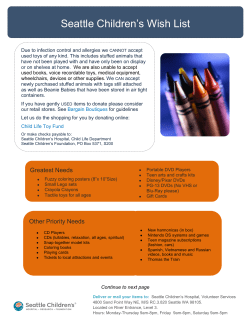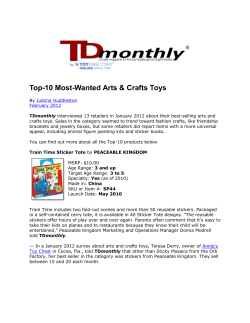
Play Can Be the Building Blocks of Learning Sally Cartwright
Play Can Be the Building Blocks of Learning Sally Cartwright Put this article on your parent bulletin board or in your parent newsletter. Share it with colleagues, including your principal. It will help you explain what children are doing while “just” (!!!) playing. T o paraphrase Ratty in T h e Wind and the Willows, there’s nothing half so much worth doing as messing about with blocks. As a matter of fact, unit blocks are accepted in varied settings around the world as one of the finest learning tools available for children. We refer to ages 3 to 6 in school, and up to age 10 at home. We refer to special wooden blocks conceived in this country in 1914 by Caroline Pratt. Their sizes are fractions and multiples of a carefully designed unit block. And, particularly important to young children, each change of size is made only in one dimension. The illustrations should make this clear. Unit blocks are available from most educational suppliers. Why are these blocks so special? Because, when used well, they enhance five major, interrelated aspects of child learning, namely: physical, emotional, social, intellectual, and intuitional development in children. For example: Physical development. U n i t block building, from the simplest pile of blocks to the complexities of cantilever, develops both large and small motor coordination and sensitive eye-hand integration. Furthermore, because they respect others’ work, Children learn to maneuver with finesse between crowded buildings, achieving balance, control, and spacial awareness. Social development. Unit block building invites group work. When children create a structure t o gether, they not only seek each other’s help, but learn to esteem different skills and opinions. Group building and play also promote getting along with others, satisfaction in contributing to the group, and responsibility not only for yourself and your work but for the whole group and its combined effort. Emotional development. Unit blocks are a dramatic material to work with. Even a small child can make something that stands out in thrce-dimensional boldness, thereby deriving a sense of stature and power. Firm, clean, and squarely cut, blocks are consistent, predictable, and nonthreatening. Because construction asks for creative initiative, it affords satisfaction. These emotional components of unit block experience invite a child’s participation in its safe miniworld of play, allowing expression and sometimes resolution of difficult feelings. Unlike Lego@, unit blocks don’t link together. You’ve got to work hard to fit and balance them, honing and testing your skill, persistence, and patience. You learn the frustations and joy of discovery in design, use, and mastery. In sum, blocks build rugged selfesteem. Intellectual development. Unit block building involves concrete operations such as one-to-one correspondence, counting, matching, sorting, fitting blocks to spaces, and using fractional parts of a whole in meaningful relationships, all with that creative child purpose so important to motivation. Unit blocks encourage productive thinking and experimentation; a child often rebuilds until she’s satisfied. And block building is problem solving. One winter morning a 3-year-old who couldn’t complete his swimming pool wall to his satisfaction finally told his p a r t n e r , “This is BIG LARGE CYLINDER BUILDING BOARD SMALL Cylinder BOARD ELLIPTICAL CURVE HALF ROMAN ARCH D O U BL E P I L L A R RAMP SIDEROAD u The Kindergarten Shapes T RI A N G L E Photos from City and Country School, 146 West 13th St., New York, NY 10011. Drawings from Community Playthings, Rt. 213, Rifton, NY 12471 where the people come in.” “But the water will run out!” After arguing, they opened the classroom window and concluded, “We don’t need water. It’s too cold to swim.” Blocks require verbal representation and interchange among the children. Blocks develop successful language use and reading readiness. And group dramatic play with blocks can be central to the entire classroom learning experience from preschool through age 6. The Goals of Block Building and Play These goals are won through the singular path and pace of each child. Physical Development and coordination of small and large muscles Achieving instant, dimensional sense of oneself in space A deft, intuitional awareness of object/space relationships A feeling of joy and competence in motor control and balance Social Intuitional development. Unit blocks, deftly made from natural wood, have a good feel and heft for young hands. Unlike realistically detailed toys, which precisely dictate recognition and use, blocks convey nonrepresentation and simplicity along with the friendly warmth of wood. They appeal to a child’s inner resources for intuition, fantas imagination, compassion, and insight. In good block building andP ramatic play, children learn through their own initiative, their own action and discovery. Here, with a minimum of adult direction, is space for intuitive, right brain learning, so often disparaged in our schools. I’ve watched with awe the sudden, sensitive perception and wisdom of 4-year-olds. With unit building blocks, parents and teachers have a wonderful way to encourage creative and disciplined independence in their young children. But it doesn’t happen often. In a friend’s home, where the playthings were usually jumbled together in a chest, 1 stepped through blocks and toys scattered across the floor to find the children slumped before the television. And the other day I stopped in at a preschool. There was a block area, but its blocks were heaped on the shelf in disa r r a y . and builiding s p a c e w a s cramped. Poor care, storage, and Cooperative play and work Following ‘group rules Accepting and respecting deviation among children Achieving satisfying friendships with compassion Sensing responsibility to the group and the self-esteem so gained Joy in group (community) accomplishment A deeply felt awareness that authority and group structure should promote individual fulfillment Building intuitive relationships with confidence Cognitive Development of relationship thinking (cause and effect; simple classifying; relatedness of objects, feelings, activities) Concrete use of counting and one-to-one correspondence, awareness and use of simple shapes, single attribute classification, and functional awareness of simple fractions and multiples of the handson unit block Knowing and using colors with purpose and satisfaction Increased joy and skill in discovery, in active learning, in striving to find information needed for one’s own purpose Growing perception of the microworld of block play as symbolic of the child’s real world-a cognitive perspective of value for reading readiness, which claims an intellectual grasp and use of symbols Pleasure and competence in effective communication (in talking, in listening, in reflecting the value of others’ thinking) Experiencing one’s own and others’ intuitive knowledge with increasing respect Emotional Development toward personality integration Strong, positive feelings about self in many roles and many skills Ability to meet new situations with resourcefulness Ability to sustain interest and overcome frustration Achieving an openness and sensitivity to an array of feelings in oneself and in others (humor, sadness, joy, tension, anger, excitement, peace, compassion. etc.) and appropriate, Conscious self-control Joy and vitality toward an intuitive/rational, loving view of one’s world space for blocks tell children that we adults don’t value their block work. But when the setup is encouraging, with a few simple rules, children become deeply involved. They will build and play with increasing interest, humor, and affection. Here are six ways to encourage good block work: 1. Store the unit blocks, visibly sorted by sizes, on low, open shelves adjacent to the space to be used for building. Don’t mix in other blocks or toys. Mark block silhouettes on the shelves to show which blocks fit where. 2. An open floor area with firm, unpatterned carpet is best. At home: for two children, 8 x 8 feet is sufficient. At a care center or school: for up to eight children playing at once you need a minimum 10 x 12 foot space that is not used for other activity or traffic during the times children may be using blocks. 3. Keep toys and accessories few, simple, and in size with the blocks. For example, adult people (‘wood dolls) should be about five inches high. I’ve found that very plain, wooden, homemade toys, which intentionally leave much to the child’s imagination, are best. When elaborate metal or plastic toys are used, block play often suffers. 4. Children should take from the shelves only what they immediately need. They can go back for more as required. An adult may occasionally and quietly pile up disused blocks to keep the area neat and open for more building. At a specified cleanup time, for which-in recognition of the children’s play momentum-a kindly lo-minute warning is given, the children should return all blocks to the shelves. This is a time when adult help is often required, when an adult role model is valuable. In contrast, except for handing blocks to a beginner for gentle encouragement, adults should not help children build. Discrete and honest approval is always welcome. But if you help a child build, she has not done the work herself and cannot be praised nor develop self-esteem with integrity. 5. Blocks (and children) must be treated with care. Except for special, controlled situations, there should be no crashing of buildings, no touching another’s building without permission of the owner, no hording, swinging, throwing, dropping. No stepping, sitting, lying, or rolling on unit blocks. While always conveying your love to the child, gently disengage him from the blocks and say with complete assurance in your heart, “I can’t allow that.” 6. Finally, adults need to respect the children (and their limits), trust them, and approach them with honesty, humor, knowledge (of child development, for a start), wise intuition, and unfailing love. It’s not a easy. Copyright 0 1988 by Sally Cartwright, Box 544, Tenants Harbor, ME 04860. Contact author for reprint permission. Make Sure Your Children’s Summer Is Safe As families and child care take advantage of n i c e programs summer weather, they also expose children to a host of health hazards, many of them related to water. The American Academy of Pediatrics offers these safety reminders to help us protect our children. You may want to post these tips on your Family Bulletin Board. l Make sure toddlers and preschoolers are always in your sight when near swimming pools and lakes. l Never leave a child unsupervised near a pool. Children are not “drown proof” because thev have had swimming lessons. Never let your child swim alone. l Do not use toys and other floating devices as substitutes for supervision. l l Home and child care program pools should have adequate fencing, rescue equipment, and a phone nearby to avoid leaving a child unattended. l Parents and caregivers should learn cardiopulmonary resuscitation (CPR) and should know the special techniques for infants and children. l The American Academy of Pediatrics recommends that organized group swimming lessons be reserved for children older than age 3. Paul Dyment, M.D., chairman of the American Academy of Pediatrics Committee on Sports Medicine, cautions parents against infant swimming classes. “There are two main risks,” he says. “One, children tend to swallow a lot of water, which can dilute the sodium content in their blood streams and cause convulsions, and two, water swallowed may transmit viruses causing infectious diarrhea in infants.” Infant swimming classes may give parents and other caretaking adults a false sense of security. It is unlikely that infants can be made “water safe.” K??
© Copyright 2025





















